The Baldur’s Gate 3 Character Creation Guide provides detailed information on how to create your character in the popular role-playing game. It covers the basics of selecting a race, class, and background, along with tips and suggestions for customizing your character’s appearance and abilities. The guide also explores the different abilities and skills available to each class, allowing players to build a character that suits their preferred playstyle. Additionally, it offers guidance on distributing attribute points and selecting spells and abilities during character creation. This comprehensive guide is a valuable resource for players looking to create a unique and powerful character in Baldur’s Gate 3..
In this comprehensive guide, we unveil the secrets to mastering Balder’s Gate 3’s character creation system, empowering you to craft a protagonist uniquely suited to your playstyle and desired narrative.
Whether you envision a cunning rogue who thrives in the shadows, a powerful mage capable of bending reality itself, or a noble warrior dedicated to upholding justice, we have the knowledge and insights to help you forge your ideal hero.
Within the vast character creation options lie the boundless potential for customization, enabling you to tailor every aspect of your adventurer’s appearance, race, class, skills, and even personal history.
We’ll delve into each of these elements, illuminating the intricacies of their mechanics and providing expert tips to guide you in making choices that best suit your playstyle and story objectives.
Beyond the aesthetics, the choices you make during character creation will reverberate throughout the game, influencing interactions with non-player characters, determining your character’s moral compass, and ultimately shaping the trajectory of your epic tale.
Our guide will illuminate the impact of these decisions, empowering you to navigate the challenging choices that lie ahead with confidence and strategic foresight.
Are you ready to craft your legend? Let us embark on this thrilling journey together.
Balder’s Gate 3 Character Creation Guide
Here’s our complete Balder’s Gate 3 character creation guide:
Origin
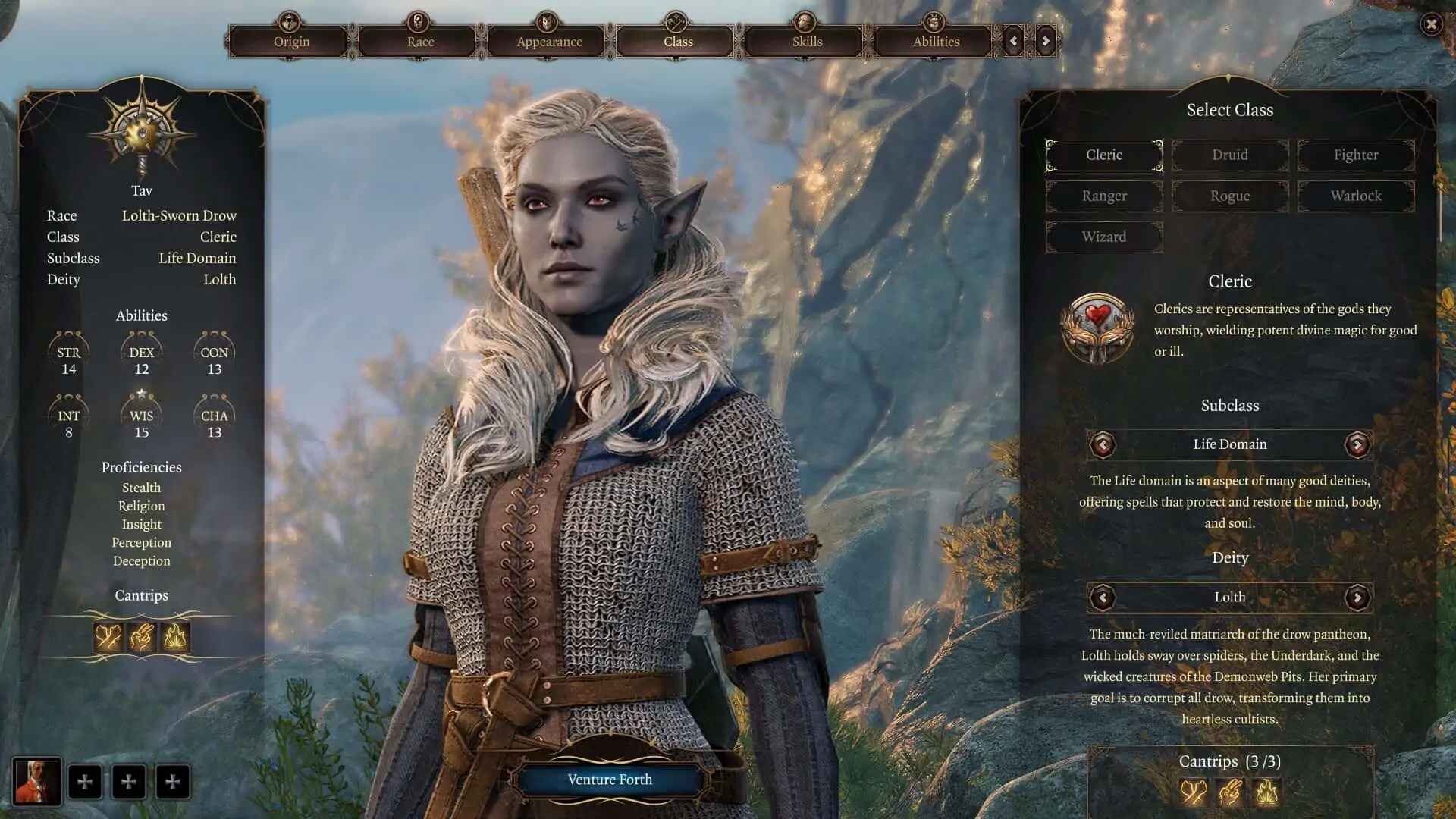
You will start out on this screen with a pre-generated character. At this point, you can definitely start the game if you aren’t too picky about creating your own character, but in these kinds of games, you should probably invest at least some time in making your own personalized adventurer.
There are five named origins, however, they are not accessible in early access. They are also some of the named NPCs that you will be able to recruit as you journey through the first Act of the game.
For future reference, however, the named Origins are:
Astarion – A Vampire High Elf Rogue.
Lae’zel – A Githyanki Fighter.
Gale – A Human Wizard.
Shadowheart – A Half-Elven Cleric.
Wyll – A Human Warlock.
Since we only have Custom origins available to us, we might as well build our own character.
Character Name
First and foremost, pick yourself a character name. The default name is Tav.
Background
There are thirteen available backgrounds to choose from, each of which will grant your character different proficiencies. What this means is that you will gain +2 to your rolls to succeed at the skill checks that your background provides. The backgrounds are:
Acolyte – “You have spent your life in service to a temple, learning sacred rites and providing sacrifices to the god or gods you worship.” This background provides proficiency in Insight and Religion.
Charlatan – “You are an expert in manipulation, prone to exaggeration, and more than happy to profit from it.” This background provides proficiency in Deception and Sleight of Hand.
Criminal – “You have a history of breaking the law and survive by leveraging less-than-legal connections”. This background provides proficiency in Deception and Stealth.
Entertainer – “You’ve always felt that you had a greater calling, but it has never borne fruit. Everything changes when you awaken imprisoned on an alien ship. Perhaps your time has finally come.” This background provides proficiency in Acrobatics and Performance.
Folk Hero – “You are a champion of the common people, challenging tyrants and monsters to protect the helpless.” This background provides proficiency in Animal Handling and Survival.
Guild Artisan – “Your skill in a particular craft has earned you membership in a mercantile guild, offering privileges and protection while engaging in your art.” This background provides proficiency in Insight and Persuasion.
Noble – “You were raised in a family among the social elite, accustomed to power and privilege.” This background provides proficiency in History and Persuasion.
Hermit – “You were once sworn to seclusion and continue to prefer solitude over the chaos of society.” This background provides proficiency in Medicine and Religion.
Outlander – “You grew up in the wilds, learning to survive far from the comforts of civilization.” This background provides proficiency in Athletics and Survival.
Sage – “You are curious and well-read, with an unending thirst for knowledge.” This background provides proficiency in Arcana and History.
Sailor – “You are familiar with the workings of ships and life at sea, having spent years weathering storms and battling creatures of the deep.” This background provides proficiency in Athletics and Perception.
Soldier – “You are trained in battlefield tactics and combat, having served in a militia, mercenary company, or officer corps.” This background provides proficiency in Athletics and Intimidation.
Urchin – “After surviving childhood on the streets, you know how to make the most out of very little.” This background provides proficiency in Sleight of Hand and Stealth.
Aside from some flavor text and proficiency bonuses, there are conversation choices in Baldur’s Gate 3 that can be unlocked by certain backgrounds. I would personally choose whichever background sounds the best for your character’s role in the party. It can also be fun to try and role-play your character’s background, but not really necessary.
Race Screen
This is where we get into a choice that will really affect how your character will interact with the game world.
Each race interacts with other races in different ways. They also have different strengths and weaknesses, so let’s break them down a little bit.
Elf Race
There are actually two sub-races of elves available in the early access. The haughty and somewhat arrogant High Elves, and the earthy and seclusionist Wood Elves.
High Elves
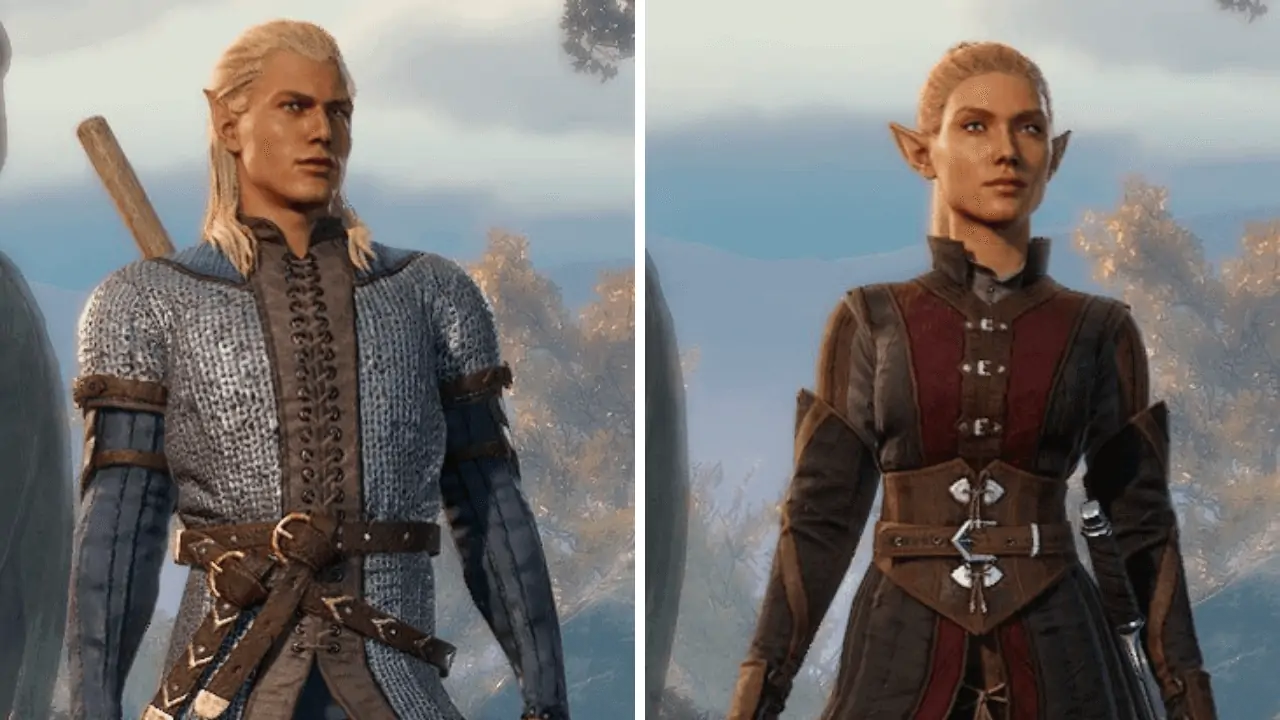
“Heirs of the Mystical Feywild, High Elves value magic in all its forms, and even those who do not study spell craft can manipulate the weave.”
Racial Features
- Cantrip – High Elves have access to a cantrip as part of their racial features. There is an array of spells to choose from as listed below:
- Acid Splash – Deals AOE acid damage.
- Blade Ward – Provides resistance against bludgeoning, piercing, and slashing weapon attacks.
- Chill Touch – Necrotic touch attack.
- Dancing Lights – A group of wisps that light a small area.
- Fire Bolt – A single-target fire attack that creates a flammable surface.
- Friends – Gives you an advantage on charisma effects to a non-hostile creature.
- Light – Gives an item a light aura so that you can see in the dark.
- Mage Hand – Create a spectral hand to interact with objects for you.
- Minor Illusion – Creates a fake image that distracts nearby creatures.
- Poison Spray – A single-target poison attack.
- Ray of Frost – A single target cold attack that creates a slippery surface.
- Shocking Grasp – A single-target electric attack that can prevent reaction abilities.
- True Strike – Gain advantage on attack rolls against a creature.
Intelligence – High Elves have a natural +1 to Intelligence.
Dexterity – High Elves have a natural +2 to Dexterity.
Keen Senses – High Elves get proficiency in perception.
Fey Ancestry – High Elves have an advantage against being charmed and cannot be put to sleep by magic.
Longsword, Short sword, Longbow, Short bow proficiency – In addition to class proficiencies, High Elves have proficiency in these weapons. Darkvision – High Elves can see up to 12 meters in the dark without light.
Movement Speed – High Elves have a base speed of 9 meters per round.
Wood Elves
“Wood Elves spend their reclusive lives in Faerun’s forests. Decades of training in archery and camouflage are enhanced by an otherworldly swiftness.”
Racial Features
- Wisdom – Wood Elves have a natural +1 to Wisdom.
- Dexterity – Wood Elves have a natural +2 to Dexterity.
- Keen Senses – Wood Elves get proficiency in perception.
- Fey Ancestry – Wood Elves have an advantage against being charmed and cannot be put to sleep by magic.
- Longsword, short sword, Longbow, short bow proficiency – In addition to class proficiencies, Wood Elves have proficiency in these weapons.
- Mask of the Wild – Wood Elves have proficiency in Stealth.
- Darkvision – Wood Elves can see up to 12 meters in the dark without light.
- Movement Speed – Wood Elves have a base speed of 10.5 meters per round.
Tiefling
There are three subraces of Tiefling present in the early access version of the game. Each follows a different Arch Devil’s Bloodline, Asmodeus, Mephistopheles, and Zariel.
Asmodeus Tiefling
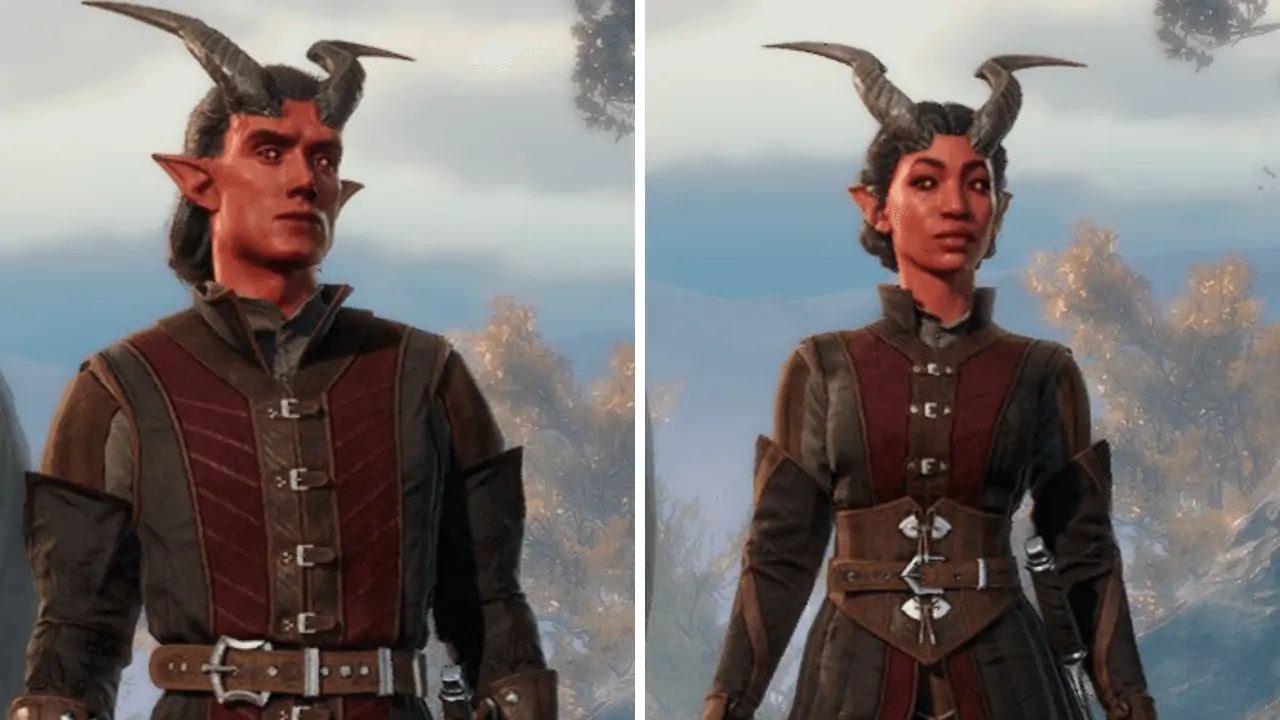
“Bound to Nessus, the deepest layer of the hells, these Tieflings inherit the ability to wield fire and darkness from the Archdevil Asmodeus’ infernal bloodline.”
Racial Features
- Cantrip – Asmodeus Tieflings have the cantrip Thaumaturgy as an innate ability granting them an advantage on intimidation and performance checks.
- Intelligence – Asmodeus Tieflings have a natural +1 to Intelligence.
- Charisma – Asmodeus Tieflings have a natural +2 to Charisma.
- Hellish Resistance – Asmodeus Tieflings have resistance to fire and only take half damage.
- Darkvision – Asmodeus Tieflings have the ability to see 12 meters in the dark without light.
- Movement Speed – Asmodeus Tieflings have a base movement speed of 9 meters per round.
Mephistopheles Tiefling
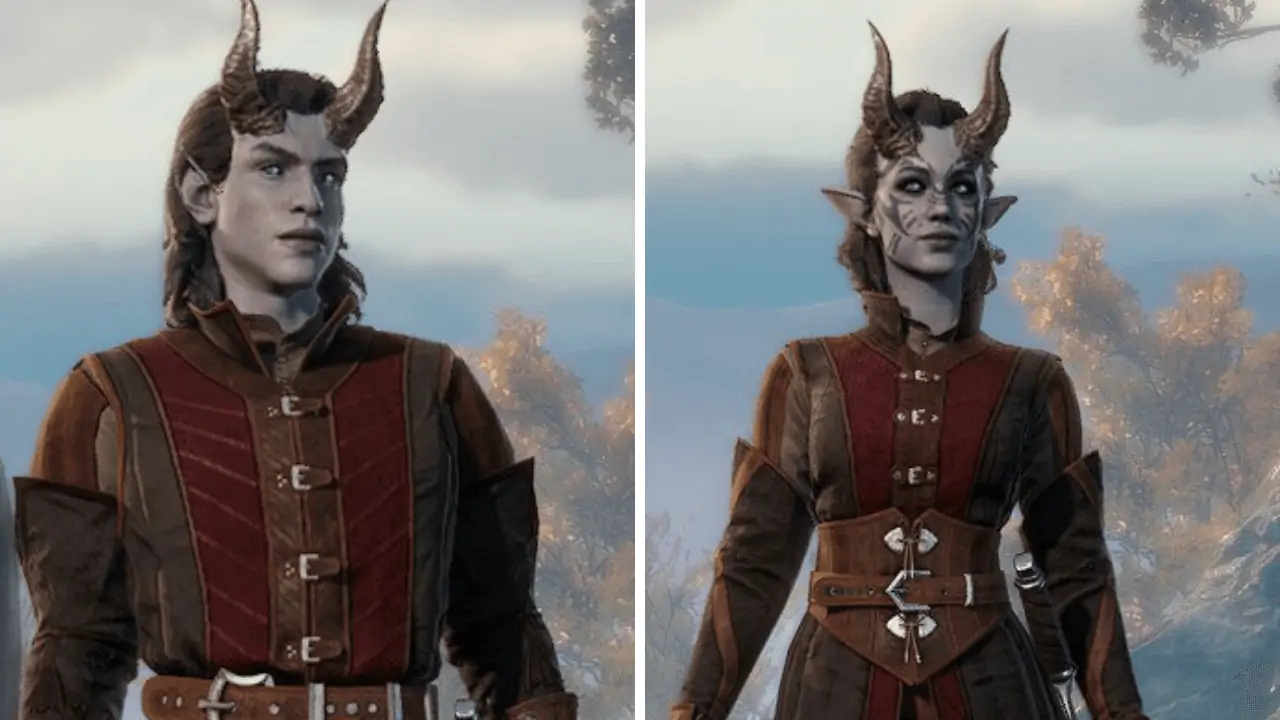
“Descended from the Archdevil Mephistopheles, these Tieflings are gifted with a particular affinity for arcane magic.”
Racial Features
- Cantrip – Mephistopheles Tieflings have the cantrip Mage Hand as an innate ability, allowing them to summon a spectral hand to interact with objects for them.
- Intelligence – Mephistopheles Tieflings have a natural +1 to Intelligence
- Charisma – Mephistopheles Tieflings have a natural +2 to Charisma.
- Hellish Resistance – Mephistopheles Tieflings have resistance to fire and only take half damage.
- Darkvision – Mephistopheles Tieflings have the ability to see 12 meters in the dark without light.
- Movement Speed – Mephistopheles Tieflings have a base movement speed of 9 meters per round.
Zariel Tiefling
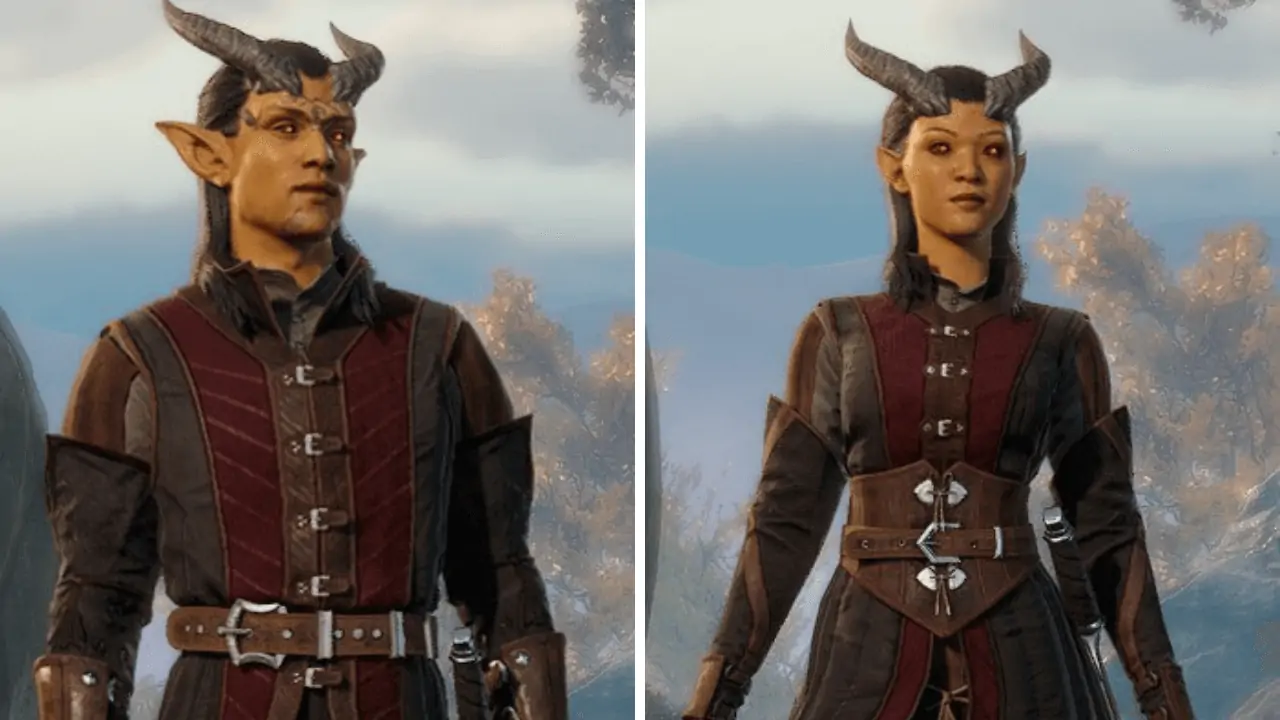
“Tieflings from Zariel’s bloodline are empowered with martial strength, and can channel searing flame to punish their enemies.”
Racial Features
- Cantrip – Zariel Tieflings have the cantrip Thaumaturgy as an innate ability granting them advantage on intimidation and performance checks.
- Strength – Zariel Tieflings have a natural +1 to Strength.
- Charisma – Zariel Tieflings have a natural +2 to Charisma.
- Hellish Resistance – Zariel Tieflings have resistance to fire and only take half damage.
- Darkvision – Zariel Tieflings have the ability to see 12 meters in the dark without light.
- Movement Speed – Zariel Tieflings have a base movement speed of 9 meters per round.
Drow
Let’s not pretend that Drow are not another sub-race of Elf, but I guess in this particular game they aren’t.
Drow also has two Sub-races of their own which really can be broken down into evil and less evil Drow, the Lolth-Sworn, and the Seldarine.
Lolth-Sworn Drow
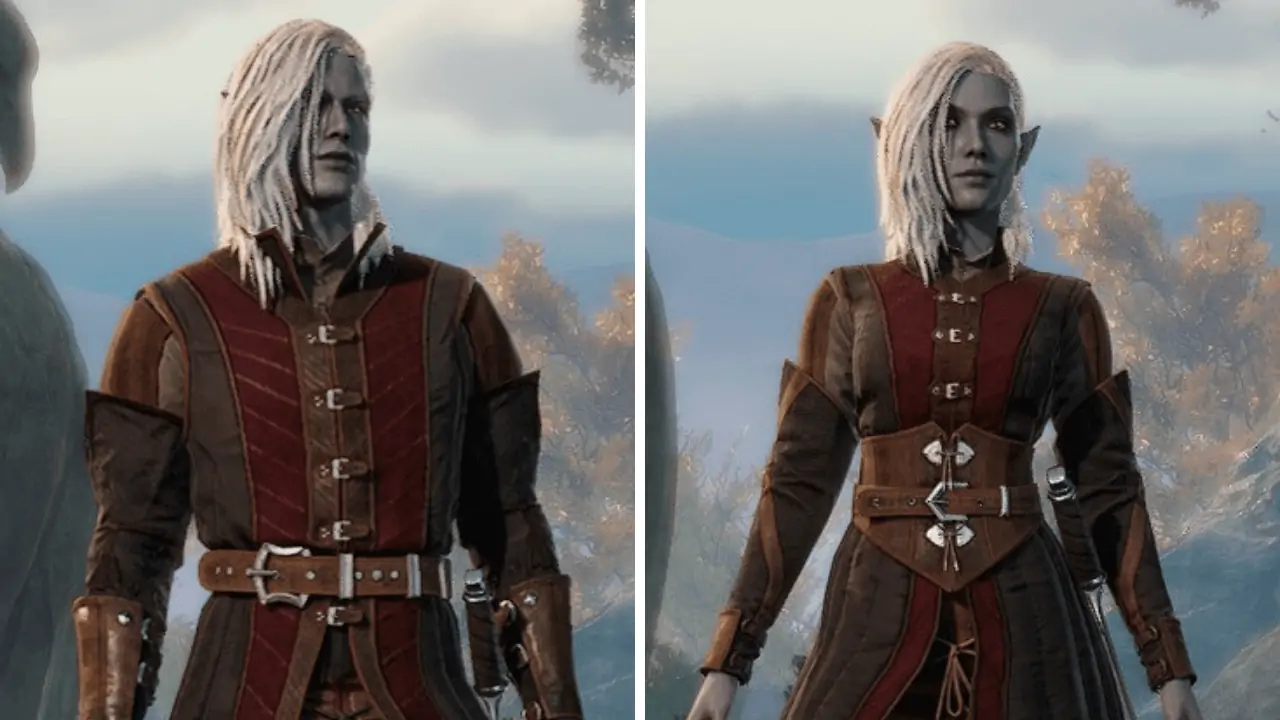
“Raised by Lolth’s cult in the city of Menzoberranzan, these Drow extol the virtues of their corrupt and merciless goddess. Lolth marks her followers with bright red eyes so the Underdark will learn to fear Drow on sight.”
Racial Features
- Cantrip – Lolth-Sworn Drow can case Dancing Lights innately, which creates wisps of light that illuminate an area.
- Fey Ancestry – Lolth-Sworn Drow have advantage against being charmed and cannot be put to sleep by magic.
- Dexterity – Lolth-Sworn Drow have a natural +2 to Dexterity.
- Charisma – Lolth-Sworn Drow have a natural +1 to Charisma. Rapier, short sword, Hand crossbow
- Proficiency – Lolth-Sworn Drow are proficient with these weapons in addition to those granted by their chosen class.
- Superior Darkvision – Lolth-Sworn Drow can see up to 24 meters in the dark without a light source.
- Movement Speed – Lolth-Sworn Drow have a base movement speed of 9 meters
Seldarine Drow
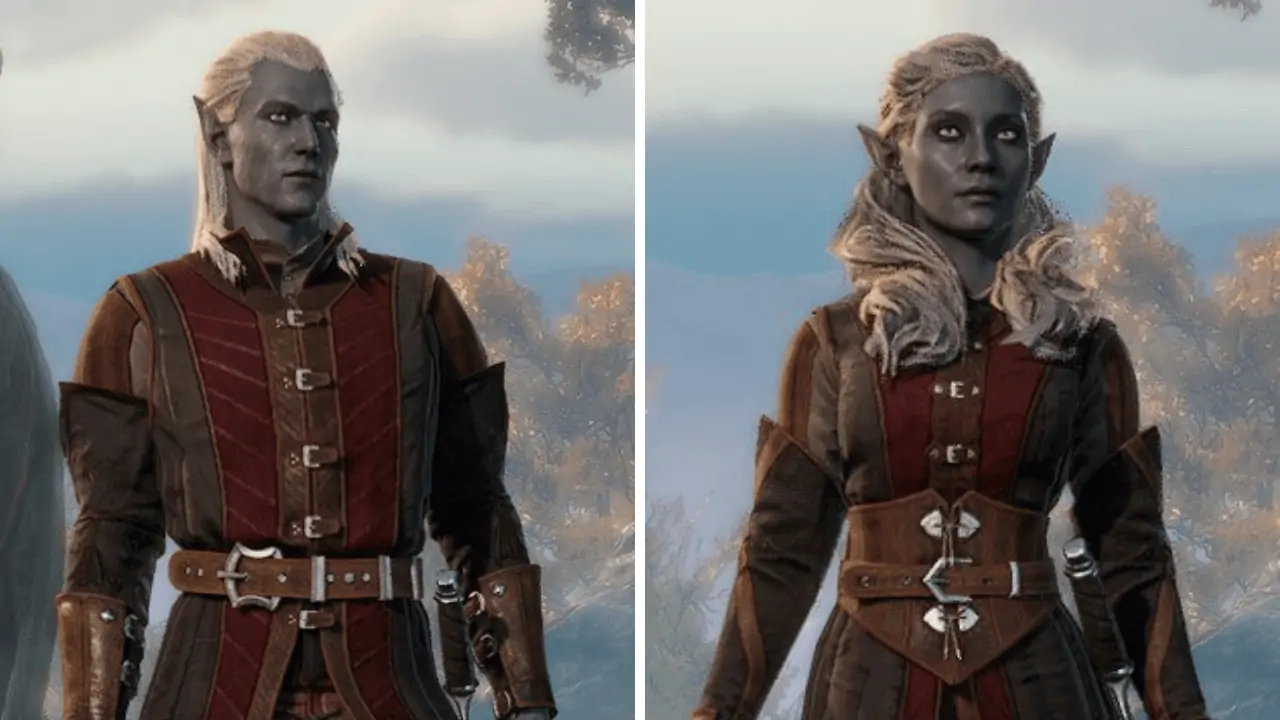
“Drow are the result of an ancient schism between the elven deities Corellon Larethian and Lolth. The latter’s treachery drove the Drow into the Underdark, where they splintered into warring factions. Seldarine Drow can be found seeking allies from all over Faerun, aiming to settle their conflict with Lolth, and each other, by any means necessary.”
Racial Features
- Cantrip – Seldarine Drow can case Dancing Lights innately, which creates wisps of light that illuminate an area.
- Fey Ancestry – Seldarine Drow have an advantage against being charmed and cannot be put to sleep by magic.
- Dexterity – Seldarine Drow have a natural +2 to Dexterity.
- Charisma – Seldarine Drow have a natural +1 to Charisma. Rapier, short sword, Hand crossbow
- Proficiency – Seldarine Drow are proficient with these weapons in addition to those granted by their chosen class.
- Superior Darkvision – Seldarine Drow can see up to 24 meters in the dark without a light source.
- Movement Speed – Seldarine Drow have a base movement speed of 9 meters per round.
Humans
Surprisingly humanity does not warrant any Sub-races. Despite the countless nations, cults, orders, or sects of humanity that have existed throughout the ages of Faerun’s history, Humanity is simply grouped together as one.
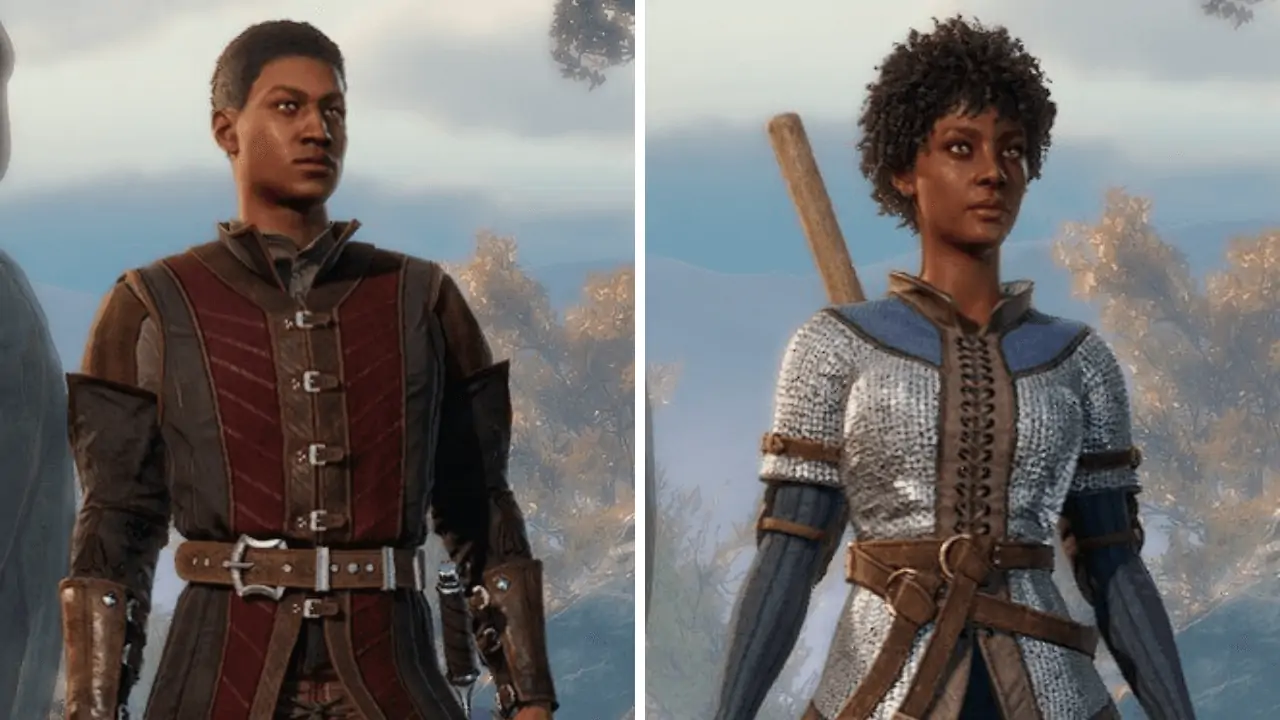
“The most common face to see in Faerun, humans are known for their tenacity, creativity, and endless capacity for growth.”
Racial Features
- Movement Speed – Humans have a base movement of speed of 9 meters per round.
- Adaptability – Humans have a natural +1 to all primary attributes (Strength, Dexterity, Constitution, Intelligence, Wisdom, and Charisma).
Githyanki
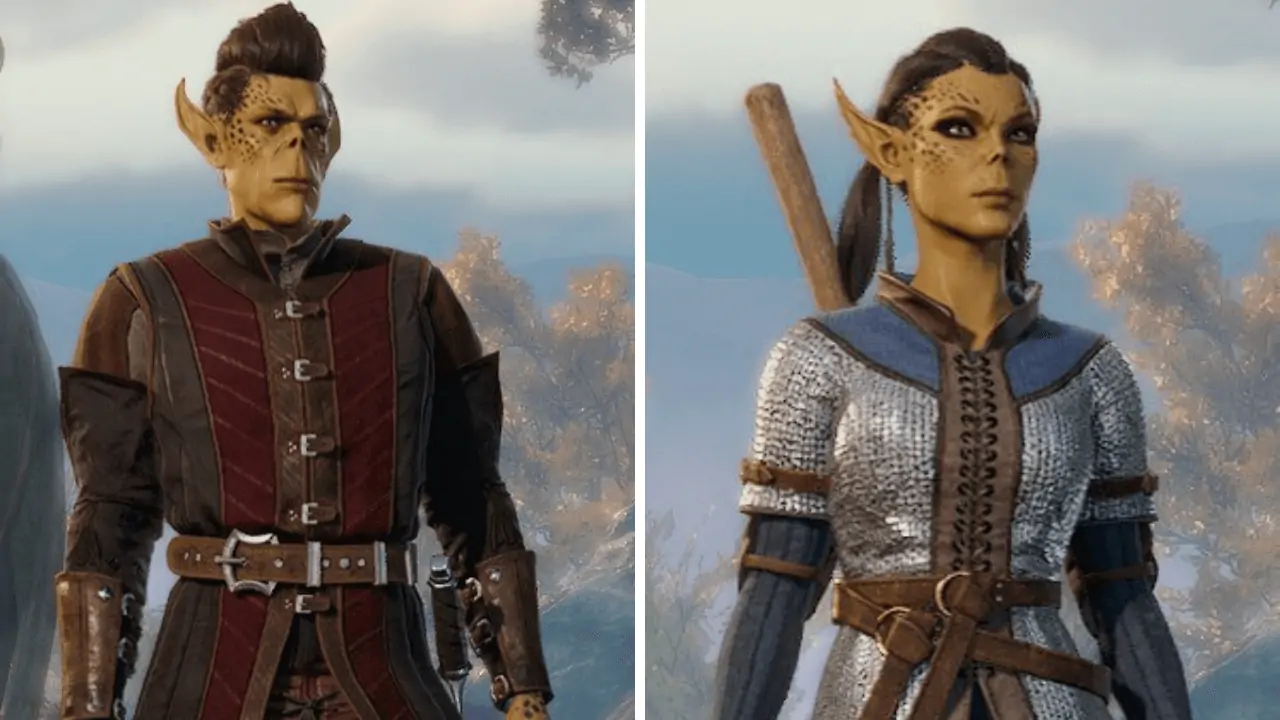
I am deeply saddened that the Githzerai are not a playable race in this game, but Githyanki are pretty cool too, I guess.
Also, can we maybe discuss how the female Githyanki are objectively pretty attractive, while the male Githyanki looks far more monstrous…
“Githyanki are peerless warriors from the Astral Plane, known for their legendary silver blades and Red Dragon mounts. They seek the total destruction of Mind Flayers (Illithid), whose ancient empire enslaved the Githyanki for millennia.”
Racial Features
- Cantrip – Githyanki have limited psionic powers and can manifest a mage hand to interact with objects on their behalf.
- Intelligence – Githyanki have a natural +1 to Intelligence.
- Strength – Githyanki have a natural +2 to Strength. Light armor, Medium armor, short sword, Longsword, Great sword
- Proficiency – Githyanki have proficiencies with these weapons and armor on top of any proficiencies granted by their class.
- Movement Speed – Githyanki have a base movement speed of 9 meters per round.
Dwarves
Why is there no fantasy realm where Dwarves aren’t in a state of decline? Anyways there are two types of Dwarves available to us, the Shield Dwarves and the Gold Dwarves.
They are not wildly different from each other, but let’s take a look.
Shield Dwarf
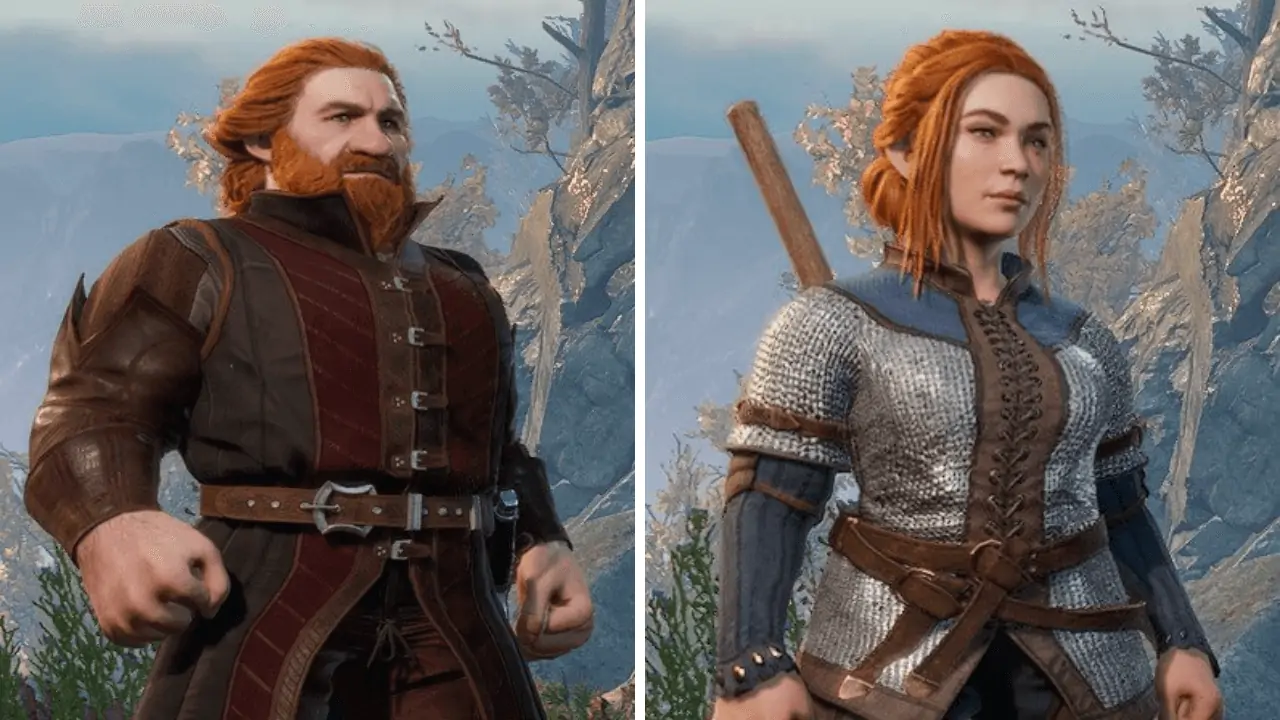
“Shield Dwarves survived a long fall from grace, surrendering many of their ancient kingdoms in wars with goblins and orcs. These losses have led to a cynical mindset, yet Shield Dwarves will endure anything to restore their ancestral homelands.”
Racial Features
- Dwarven Resilience – Shield Dwarves have an advantage on saving throws against poison and take half damage from poison.
- Strength – Shield Dwarves have a natural +2 to Strength.
- Constitution – Shield Dwarves have a natural +2 to Constitution.
- Battleaxe, Hand axe, Light Hammer, Warhammer, Light Armor, Medium Armor proficiency – Shield Dwarves have proficiency with these weapons and armor in addition to those granted by their class.
- Darkvision – Shield Dwarves can see up to 12 meters in the dark without a source of light.
- Movement Speed – Shield Dwarves have a base movement speed of 7.5 meters per round.
Gold Dwarf
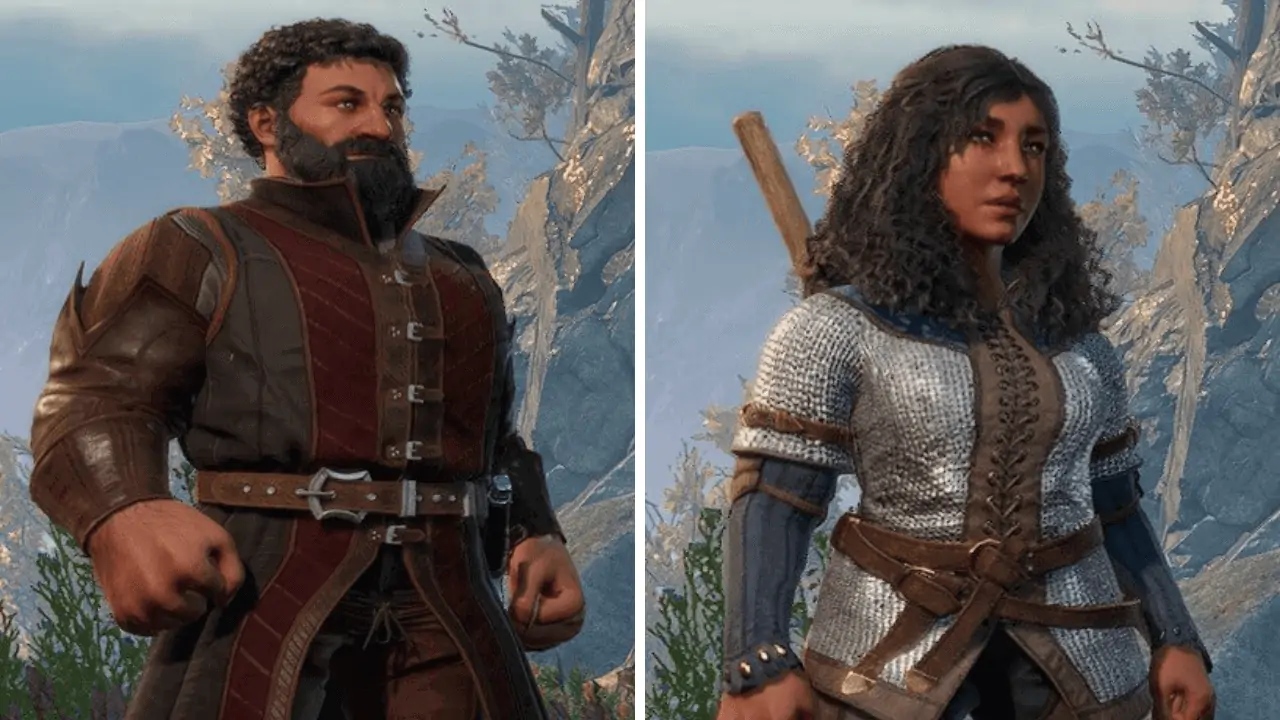
“Gold Dwarves are known for their confidence and keen intuition. The culture of their Deep Kingdom values family, ritual, and fine craftsmanship.”
Racial Features
- Dwarven Resilience – Gold Dwarves have an advantage on saving throws against poison and take half damage from poison.
- Constitution – Gold Dwarves have a natural +2 to Constitution.
- Wisdom – Gold Dwarves have a natural +1 to Wisdom Battle axe, Hand axe, Light Hammer, Warhammer, Light Armor, Medium Armor proficiency – Gold Dwarves have proficiency with these weapons and armors in addition to those granted by their class.
- Dwarven Toughness – Gold Dwarves gain an additional +1 hit point per level.
- Darkvision – Gold Dwarves can see up to 12 meters in the dark without a source of light.
- Movement Speed – Gold Dwarves have a base movement speed of 7.5 meters per round.
Half-Elf
Half-Elves have the fairly unique ability to somewhat customize their bonuses and allow you a little bit of extra control over your character.
They have some of the benefits of being an elf, with just a sprinkling of Human adaptiveness.
High Half-Elf
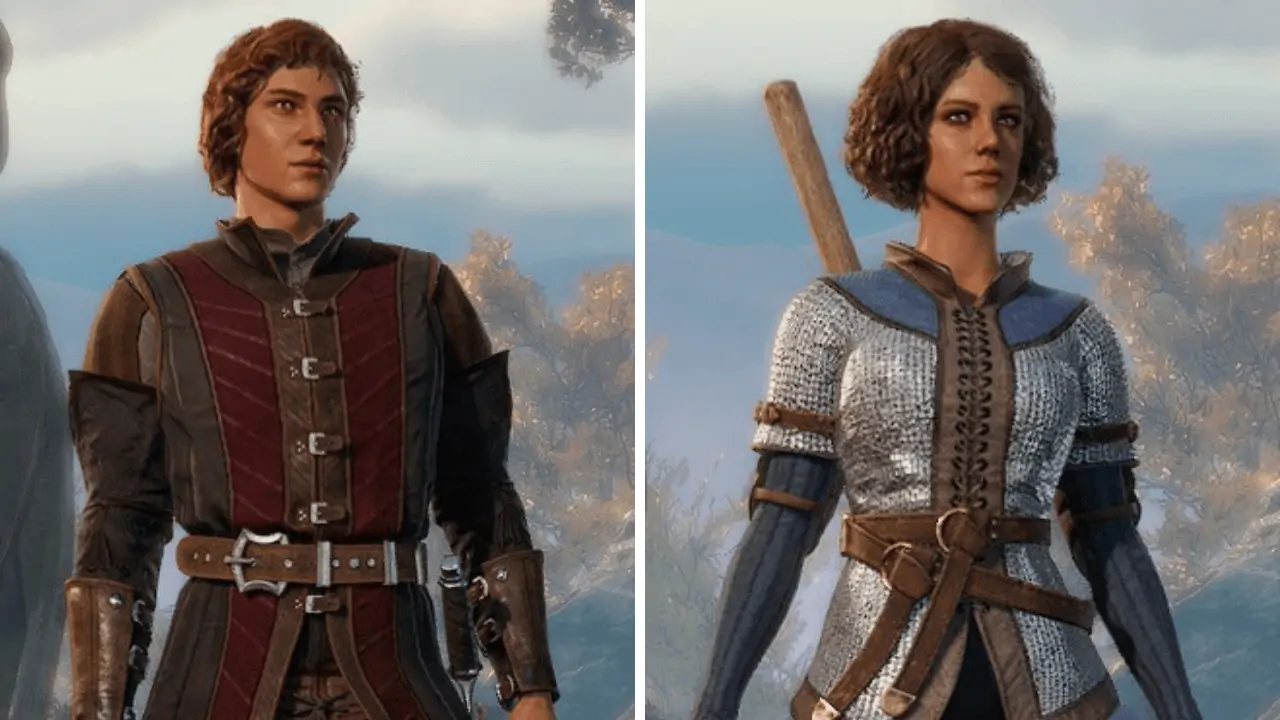
“A touch of the Feywild remains in Half-Elves with this bloodline, and even those untrained in magic possess a hint of wild power.”
Racial Features
- Cantrip – High Half-Elves, like their High Elf progenitors have the ability to choose a cantrip at level one. The cantrips you can choose and their general effects are:
- Acid Splash – Deals AOE acid damage.
- Blade Ward – Provides resistance against bludgeoning, piercing and slashing weapon attacks.
- Chill Touch – Necrotic touch attack. Dancing Lights – A group of wisps that light a small area.
- Fire Bolt – A single-target fire attack that creates a flammable surface.
- Friends – Gives you an advantage on charisma effects to a non-hostile creature.
- Light – Gives an item a light aura so that you can see in the dark.
- Mage Hand – Create a spectral hand to interact with objects for you.
- Minor Illusion – Creates a fake image that distracts nearby creatures.
- Poison Spray – A single-target poison attack.
- Ray of Frost – A single target cold attack that creates a slippery surface.
- Shocking Grasp – A single-target electric attack that can prevent reaction abilities.
- True Strike – Gain advantage on attack rolls against a creature.
Ability Improvements – Unlike other races, Half-Elves are given two points to “spend” on any of the six abilities. If you want a particularly burly Half-Elf you can throw one point into Strength and another into Constitution. Alternatively, if you want a smart, charismatic Half-Elf throw a point into intelligence and charisma. You can choose any two abilities to put one point into. Unfortunately, you cannot dump both points into the same ability.
Charisma – High Half-Elves have a natural +2 to Charisma.
Fey Ancestry – High Half-Elves have an advantage against being charmed and cannot be put to sleep by magic.
Darkvision – High Half-Elves can see up to 12 meters in the dark without a source of light.
Movement Speed – High Half-Elves have a base movement speed of 9 meters per round.
Wood Half-Elf
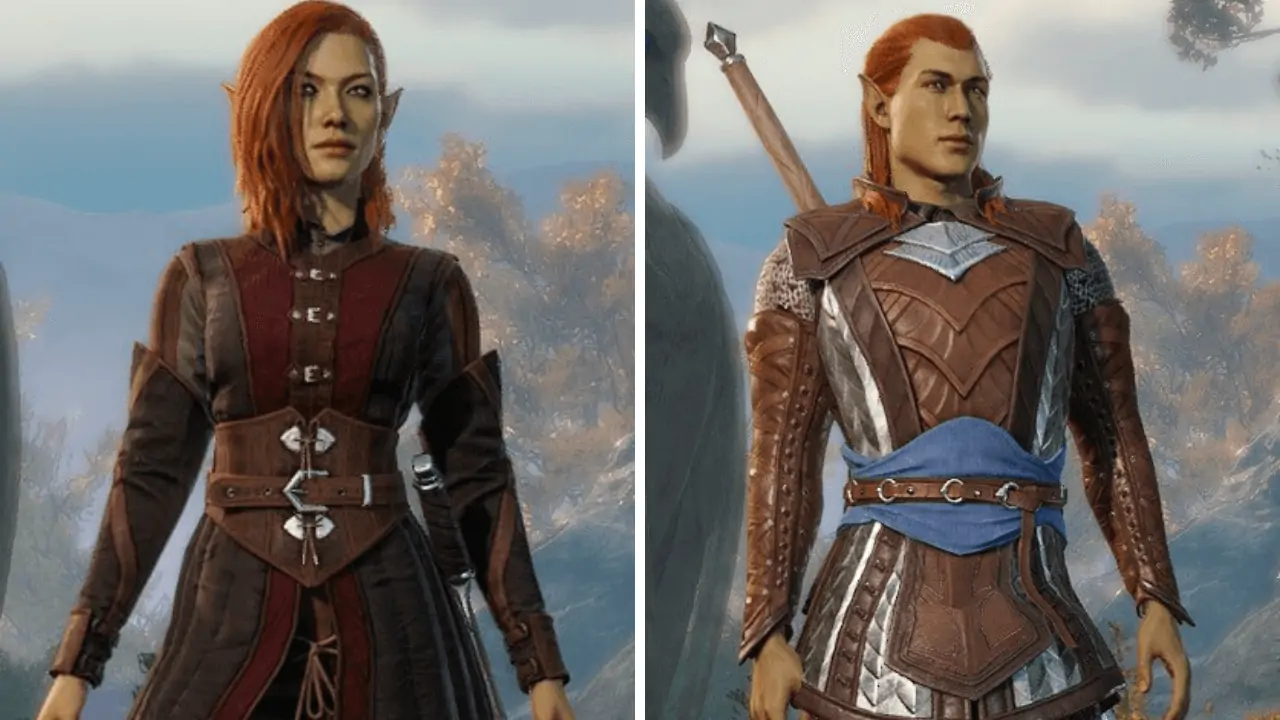
“Like their Wood Elf parent, these Half-Elves have a quickened stride and eye for stealth. Yet many break away from the isolation in Faerun’s forests to explore the rest of the Realms.”
Racial Features
Ability Improvements – Unlike other races, Half-Elves are given two points to “spend” on any of the six abilities. If you want a particularly burly Half-Elf you can throw one point into Strength and another into Constitution. Alternatively, if you want a smart, charismatic Half-Elf throw a point into intelligence and charisma. You can choose any two abilities to put one point into. Unfortunately, you cannot dump both points into the same ability.
Charisma – Wood Half-Elves have a natural +2 to Charisma.
Fey Ancestry – Wood Half-Elves have an advantage against being charmed and cannot be put to sleep by magic.
Mask of the Wild – Wood Half-Elves have proficiency in Stealth.
Darkvision – Wood Half-Elves can see up to 12 meters in the dark without a source of light.
Movement Speed – Wood Half-Elves have a base movement speed of 10.5 meters per round.
Drow Half-Elf
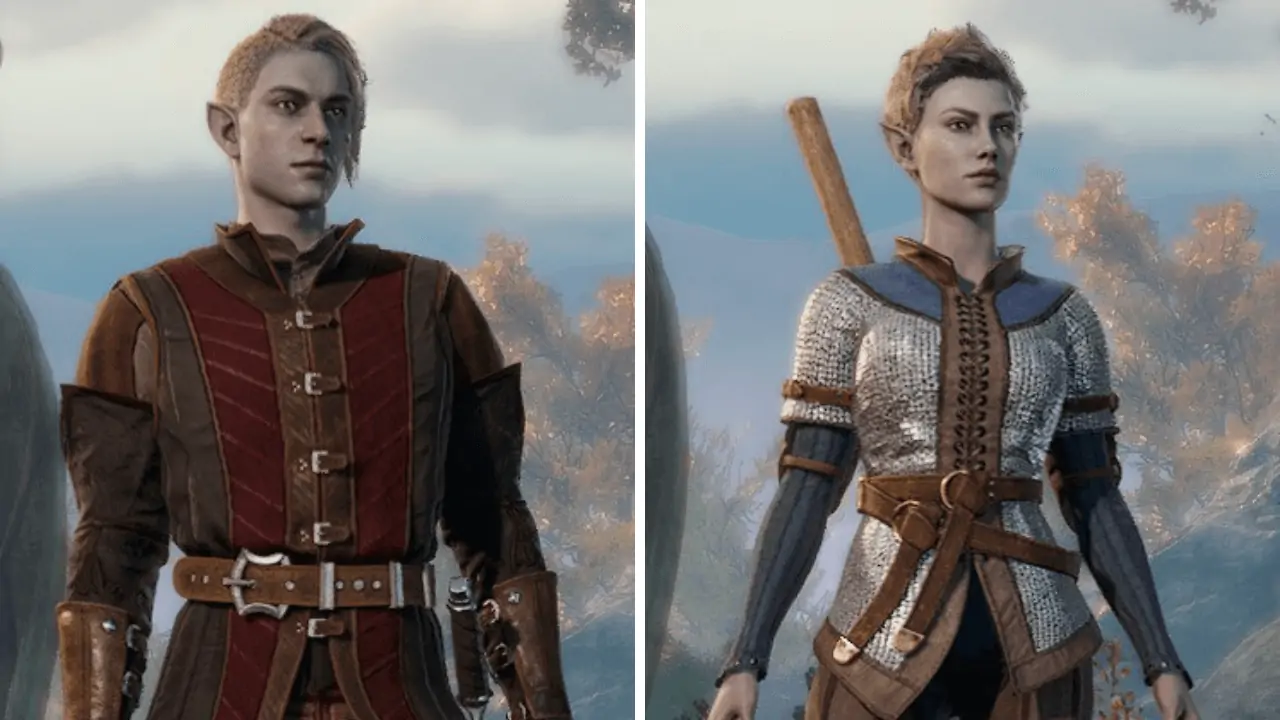
“Most Half-Drow result from liaisons between Seldarine Drow and surfacers. While Half-Drow inherit a few magical gifts, they aren’t usually raised in the Underdark.”
Racial Attributes
Ability Improvements – Unlike other races, Half-Elves are given two points to “spend” on any of the six abilities. If you want a particularly burly Half-Elf you can throw one point into Strength and another into Constitution. Alternatively, if you want a smart, charismatic Half-Elf throw a point into intelligence and charisma. You can choose any two abilities to put one point into. Unfortunately, you cannot dump both points into the same ability.
Charisma – Wood Half-Elves have a natural +2 to Charisma. Fey Ancestry – Wood Half-Elves have an advantage against being charmed and cannot be put to sleep by magic.
Darkvision – Wood Half-Elves can see up to 12 meters in the dark without a source of light.
Movement Speed – Wood Half-Elves have a base movement speed of 9 meters per round.
Cantrip – Drow Half-Elves can case Dancing Lights innately, which creates wisps of light that illuminate an area.
Halflings If you have ever wanted to be a hobbit from Lord of the Rings, here is your chance. Halflings are diminutive creatures that are naturally lucky and determined in the face of danger.
In this game, Halflings come in two brands, Lightfoot and Strongheart.
Lightfoot Halfling
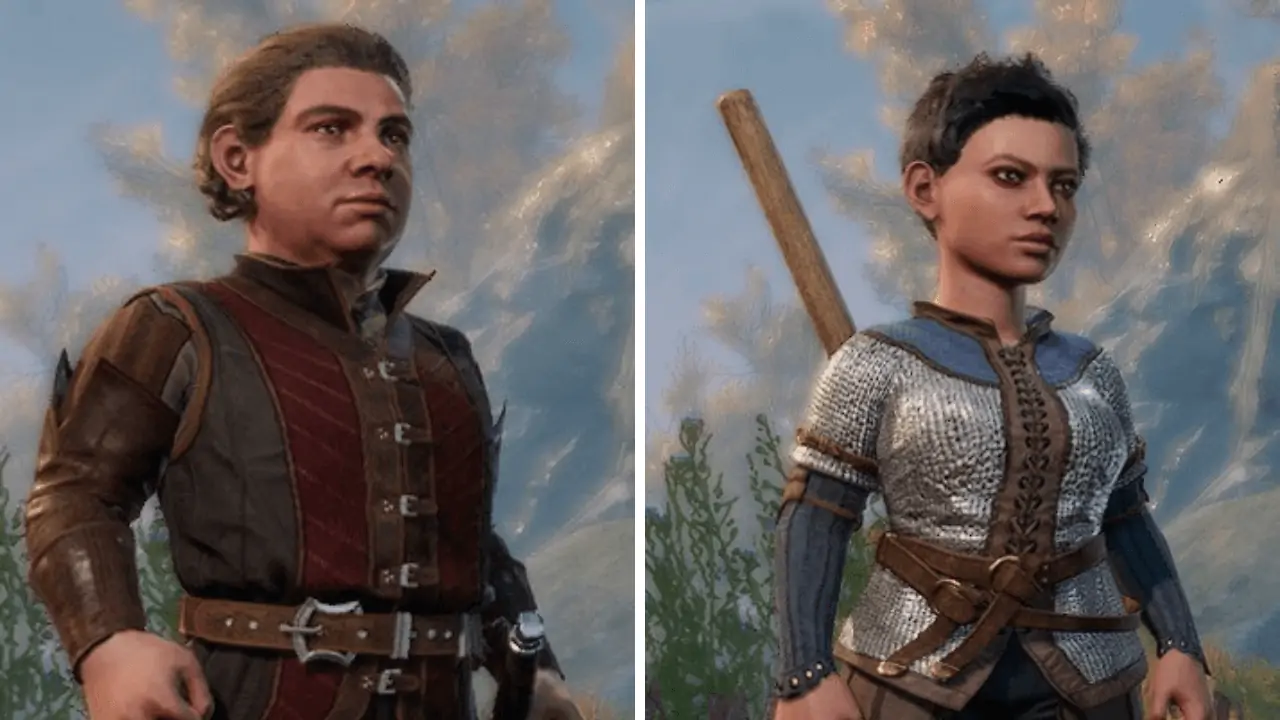
“Lightfoot Halflings are stealthy but social, traveling all over Faerun to make names for themselves.”
Racial Attributes
- Dexterity – Lightfoot Halflings have a natural +2 to Dexterity
- Charisma – Lightfoot Halflings have a natural +1 to Charisma
- Lucky – If a Lightfoot Halfling rolls a 1 on an attack, ability, skill, or saving through roll, they can reroll the dice and must use the new roll.
- Naturally Stealthy – Lightfoot Halflings have an advantage on stealth checks.
- Movement Speed – Lightfoot Halflings have a base movement speed of 7.5 meters per round.
Strongheart Halfling
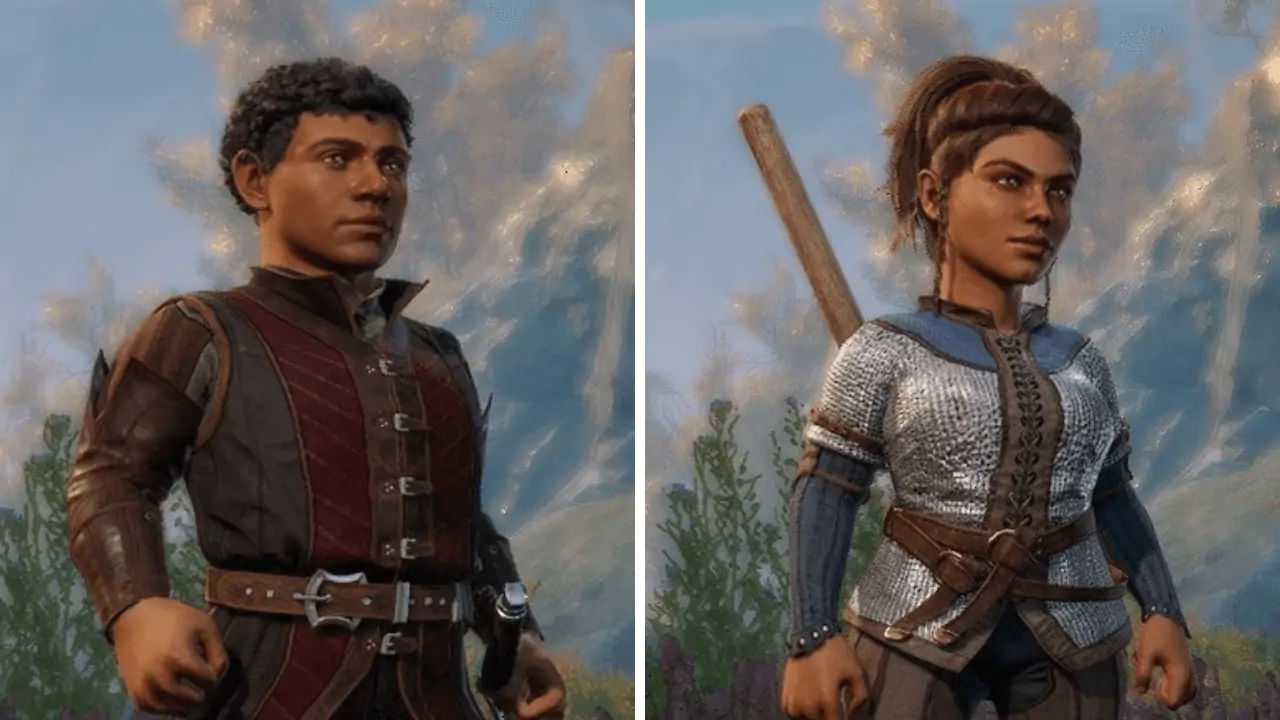
“Legends say Dwarven blood gave Stronghearts their hardiness. Resistant to poison and wellsprings of endurance, these Halflings easily hold their own.”
Racial Attributes
- Dexterity – Strongheart Halflings have a natural +2 to Dexterity
- Constitution – Strongheart Halflings have a natural +1 to Constitution
- Lucky – Strongheart Halfling rolls a 1 on an attack, ability, skill, or saving through roll, they can reroll the dice and must use the new roll.
- Strongheart Resilience – Strongheart Halflings have an advantage on poison saving throws and have resistance to poison damage.
- Movement Speed – Lightfoot Halflings have a base movement speed of 7.5 meters per round.
Class Screen
There are six classes available in the early access of Baldur’s Gate 3.
There may be up to twelve classes available upon release, but for now, we have to make do with what we have.
Cleric
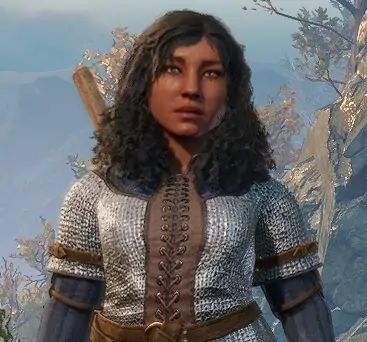
Clerics in Dungeons and Dragons have always been an interesting choice. There are so many different paths you can go as a Cleric. Do you want to stand on the front line and dish out some melee damage in addition to casting buffs and healing spells? Do you want to stand back and blast enemies with holy fire?
These are just two viable play styles among the many that Clerics can take depending on your ability distribution and equipment.
“Clerics are representatives of the gods they worship, wielding potent divine magic for good or ill.”
The first thing you are going to have to choose as a Cleric is your Subclass. There are three domains available so far in Early Access, each offering different benefits. Each subclass offers different features and domain spells.
General Cleric Features
- Hit Points – Clerics start with 8 + Con modifier hit points. Every subsequent level they will gain up to 8 + Con modifier hit points.
- Wisdom Saving Throw Proficiency – Clerics gain their proficiency bonus to Charisma saving throws. This is +2 from levels 1 to 4, and will increase to +3 at level 5, and +4 at level 9.
- Charisma Saving Throw Proficiency – Clerics gain their proficiency bonus to Charisma saving throws. This is +2 from levels 1 to 4, and will increase to +3 at level 5, and +4 at level 9.
- Light and Medium Armor Proficiency – Clerics are able to wear light and medium armor without being subject to attack disadvantage penalties. In addition, Clerics can cast spells while wearing light and medium armor.
- Shield Proficiency – Clerics can carry shields without being subject to attack disadvantage penalties. In addition, Clerics can cast spells while wearing a shield. Simple Weapon
- Proficiency – Clerics are proficient with all simple weapons and add their proficiency bonus to attack rolls with these weapons.
Cantrips (You will be able to choose 3)
- Guidance – Grant a targeted creature a 1d4 bonus to ability checks.
- Light – Causes an item to act as a light source.
- Resistance – Grants a targeted creature a 1d4 bonus to saving throws.
- Sacred Flame – Causes 1d8 radiant damage to a targeted creature.
- Thaumaturgy – Grants you an advantage on intimidation and performance checks.
Prepared Spells (You will be able to choose 3)
- Bane – Gives a 1d4 penalty to attack and saving throws for up to 3 creatures.
- Bless – Gives a 1d4 bonus to attack and saving throws for up to 3 creatures.
- Command (Halt) – Stops a targeted creature from moving or using actions.
- Create Water – Causes rain to fall, putting out fires and creating a water surface.
- Cure Wounds – Touch a target to heal them for 1d8 + (wisdom) hit points.
- Guiding Bolt – Deals 4d6 radiant damage to a targeted creature and causes the next attack against the creature to be at advantage.
- Healing Word – Heals 1d4 + (wisdom modifier) hit points to a target that you can see.
- Inflict Wounds – A touch attack that causes 3d10 necrotic damage.
- Protection from Good/Evil – Protects against charmed, frightened, or possession from aberrations, celestials, elementals, fey, fiends, and undead. Also causes attacks against you by those creatures to be made with a disadvantage.
- Shield of Faith – Provides a +2 AC shield on a targeted creature.
Life Domain
- Heavy Armor Proficiency – Life Clerics are able to wear heavy armor without being subject to attack disadvantage penalties. In addition, Life Clerics can cast spells while wearing heavy armor.
- Disciple of Life – When casting a healing spell, your target heals an additional 2 hit points + another hit point for each spell level of the spell.
- Domain Spells – Life Clerics always have the spells Bless and Cure Wounds prepared.
Light Domain
- Warding Flare – As a reaction you can give a disadvantage to an attacker.
- Domain Spells – Light Clerics always have the spells Burning Hands, Faerie Fire, Light, Bless, and Cure Wounds prepared.
- Faerie Fire – Makes targets visible and grants advantage on attack rolls against them by outlining them in light.
- Burning Hands – A cone of fire that deals 3d6 fire damage.
- Trickery Domain Domain Spells – Trickery Clerics always have the spells Charm Person, Disguise Self, Blessing of the Trickster, Bless, and Cure Wounds prepared.
- Charm Person – Grants advantage on Charisma checks against the charmed creature and the charmed creature cannot attack the charmer.
- Disguise Self – Magically alters your appearance.
- Blessing of the Trickster – Grants advantage on stealth checks for the targeted creature.
Fighter
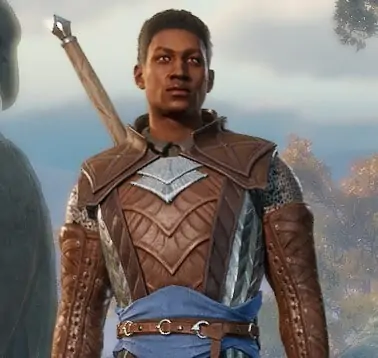
Fighters are the bread and butter of Dungeons and Dragons. They are generally considered to be the easiest class to learn and play.
They are perfect for beginners who just want a character that can go punch things in the face and take some hits without dying.
“Fighters have mastered the art of combat, wielding weapons with unmatched skill and wearing armour like a second skin.”
Class Passives
Fighters in 5th Edition have a choice at level one of the general path they want their weapon focus to take. Each grants a different bonus to certain fighting styles, as detailed below:
- Archery – +2 bonus to attack rolls made with ranged weapons.
- Defense – +1 armor class while wearing armor.
- Dueling – +2 damage when using a one-handed weapon if the other hand is empty.
- Great Weapon Fighting – When using a two-handed weapon, reroll your attack roll if it is a 1 or a 2. You must use the second roll.
- Protection – When using a shield, give a disadvantage to an enemy attacking an ally when you are within 1.5 meters of them. You must be able to see the enemy.
- Two-Weapon Fighting Style – Add your ability modifier (Str or Dex) to your offhand attack damage.
Hit Points – Fighters start with 10 + Con modifier hit points. Every subsequent level they will gain up to 10 + Con modifier hit points.
Fighter Features
- Strength Saving Throw Proficiency – Fighters gain their proficiency bonus to Strength saving throws. This is +2 from levels 1 to 4, and will increase to +3 at level 5, and +4 at level 9.
- Constitution Saving Throw Proficiency – Fighters gain their proficiency bonus to Constitution saving throws. This is +2 from levels 1 to 4, and will increase to +3 at level 5, and +4 at level 9.
- Light, Medium, Heavy Armor, and Shield Proficiencies – Fighters are able to use all armor types and shields without being subject to attack disadvantage penalties.
- Simple and Martial Weapon Proficiency – Fighters are able to use all simple and martial weapon types and add their proficiency bonus to attack rolls made with these weapons.
- Second Wind – Fighters can heal 1d10+1 hit points as a bonus action.
Ranger
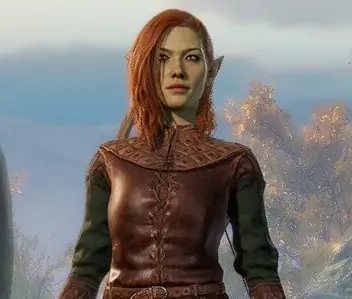
Rangers are a little bit more complicated than fighters. They excel at hunting and killing specific enemy types, and perform better on the terrain types that they favor. They also can little bit less tanky than fighters and typically have less armor (depending on your favored enemy).
Favored Enemy
The first thing that a Ranger has to pick is his favored enemy type. There are five types to choose from in Baldur’s Gate 3 and each provides a different bonus.
- Bounty Hunter – Gain proficiency in Investigation and restrained creatures have a harder time escaping.
- Keeper of the Veil – Gain proficiency in Arcana and gain the ability to cast protection from good/evil.
- Mage Breaker – Gain proficiency with Arcana and gain the ability to cast true strike.
- Ranger Knight – Gain proficiency with History and gain proficiency with Heavy Armor.
- Sanctified Stalker – Gain proficiency in Religion and gain the ability to cast Sacred Flame.
Natural Explorer
You are also going to have to choose a favored terrain. There are again five choices and each provides a different bonus.
- Beast Tamer – Grants the Find Familiar spell/ritual.
- Urban Tracker – Gain proficiency with disguise kit and thieves’ tools.
- Wasteland Wanderer (Cold) – Take half-damage from cold.
- Wasteland Wanderer (Fire) – Take half-damage from fire.
- Wasteland Wanderer (Poison) – Take half-damage from poison.
Spells (Depending on your Favored Enemy and Natural Explorer choices)
- Find Familiar – Summon a fey animal spirit to serve you.
- Protection from Good/Evil – Protects against charmed, frightened, or possession from aberrations, celestials, elementals, fey, fiends, and undead. Also causes attacks against you by those creatures to be made with a disadvantage.
- Sacred Flame – Causes 1d8 radiant damage to a targeted creature.
- True Strike – Gain advantage on attack rolls against a creature.
Further Features
- Hit Points – Rangers start with 10 + Con modifier hit points. Every subsequent level they will gain up to 10 + Con modifier hit points.
- Strength Saving Throw Proficiency – Rangers gain their proficiency bonus to Strength saving throws. This is +2 from levels 1 to 4, and will increase to +3 at level 5, and +4 at level 9.
- Dexterity Saving Throw Proficiency – Rangers gain their proficiency bonus to Dexterity saving throws. This is +2 from levels 1 to 4, and will increase to +3 at level 5, and +4 at level 9.
- Light and Medium Armor and Shield proficiency – Rangers are able to use light and medium armor types and shields without being subject to attack disadvantage penalties.
- Simple and Martial Weapon Proficiency – Rangers are able to use all simple and martial weapon types and add their proficiency bonus to attack rolls made with these weapons.
Rogue

Rogues are a pretty neat class. They definitely require a little more skill to play than a fighter or even a ranger. Their strength is based on positioning and gaining an advantage over their enemies. I would recommend playing one to someone who is familiar with the 5th edition rules, especially those around advantage, stealth, and sneak attacks.
“With stealth, skill, and uncanny reflexes, a rogue’s versatility lets them get the upper hand in almost any situation.”
- Hit Points – Rogues start with 8 + Con modifier hp. Every subsequent level they will gain up to 8 + Con modifier hit points.
- Dexterity Saving Throw Proficiency – Rogues gain their proficiency bonus to Dexterity saving throws. This is +2 from levels 1 to 4, and will increase to +3 at level 5, and +4 at level 9.
- Intelligence Saving Throw Proficiency – Rogues gain their proficiency bonus to Intelligence saving throws. This is +2 from levels 1 to 4, and will increase to +3 at level 5, and +4 at level 9.
- Light Armor proficiency – Rogues are able to use light armor without being subject to attack disadvantage penalties.
- Simple Weapon, Hand Crossbow, Longsword, Rapier, and Short Sword proficiency – Rogues add their proficiency bonus to attacks made with the aforementioned weapons. It is advisable to stick with these weapons.
- Sneak Attack – Rogues can sneak attack in melee or at ranged as long as the enemy is distracted (you have an advantage or another enemy of the target is within 1.5 meters of it). You cannot sneak attack if you have a disadvantage for any reason. Sneak attack begins at 1d6 additional damage. It increases to 2d6 at level 3 and an additional 1d6 every two levels after that.
Warlock
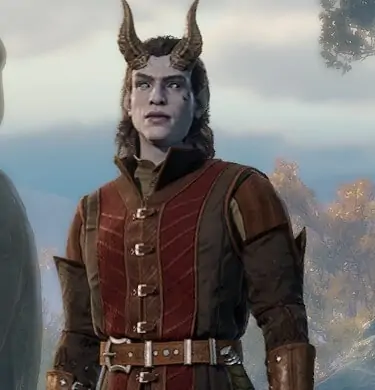
Warlocks are among my favorite classes in Dungeons and Dragons. They usually have a pretty rich back story due to the fact that they have made a pact with a Devil and that fell entity is the one that provides them with their powers.
“Bound by a pact to an all-powerful patron, warlocks trade their loyalty for supernatural abilities and unique magic.”
General Warlock Class Features
- Hit Points – Warlocks start with 8 + Con modifier hit points. Every subsequent level they will gain up to 8 + Con modifier hit points.
- Warlock Spell Slots – These spells replenish on a short rest instead of a long rest.
- Wisdom Saving Throw Proficiency – Warlocks gain their proficiency bonus to Wisdom saving throws. This is +2 from levels 1 to 4, and will increase to +3 at level 5, and +4 at level 9.
- Charisma Saving Throw Proficiency – Warlocks gain their proficiency bonus to Charisma saving throws. This is +2 from levels 1 to 4, and will increase to +3 at level 5, and +4 at level 9.
- Light Armor Proficiency – Warlocks are able to use light armor without being subject to disadvantageous penalties. In addition, Warlocks can cast spells while wearing light armor.
- Simple Weapon Proficiency – Warlocks add their proficiency bonus to attacks made with simple weapons. You are going to have to choose as a Warlock is your Subclass. There are two patrons available so far in Early Access, each offering different benefits and some spells.
Cantrips (You will be able to choose two)
- Blade Ward – Take half damage from bludgeoning, piercing, and slashing attacks.
- Chill Touch – A ranged necrotic attack that deals 1d8 damage and the target cannot regain hit points. Undead creatures will also incur a disadvantage on attack rolls.
- Eldritch Blast – A blast of force that deals 1d10 damage.
- Friends – Gain an advantage on charisma checks against a targeted creature.
- Mage Hand – Create a spectral hand to interact with objects for you.
- Poison Spray – A single-target poison attack.
- True Strike – Gain advantage on attack rolls against a creature.
The Fiend
“Warlocks in Service to fiends work towards corrupting, destructive ends – intentionally or otherwise – and receive hellish blessings in turn.”
Spells (You will be able to choose two)
- Armor of Agathys – Gain 5 temporary hit points and deal 5 cold damage to melee attackers that hit you.
- Arms of Hadar – Deal 2d6 necrotic damage to targets and targets cannot take reaction actions.
- Burning Hands – A cone of fire that deals 3d6 fire damage.
- Charm Person – Grants advantage on Charisma checks against the charmed creature and the charmed creature cannot attack the charmer.
- Command (Halt) – Stops a targeted creature from moving or using actions.
- Expeditious Retreat – Dash becomes a bonus action instead of a standard action.
- Hellish Rebuke – Causes an enemy that deals damage to you to take 2d10 fire damage.
- Hex – Target takes an extra 1d6 necrotic damage whenever the warlock hits them with an attack. The target also has a disadvantage on ability checks for one ability of your choice.
- Protection from Good/Evil – Protects against charmed, frightened, or possession from aberrations, celestials, elementals, fey, fiends, and undead.
- Witch Bolt – Causes 1d12 lightning damage to target. Each subsequent turn you can activate a link to cause a 1d12 damage without having to make a ranged attack roll.
- Dark One’s Blessing – When you reduce a hostile creature to 0 hit points, you gain hit points equal to your character level + your Charisma modifier.
The Great Old One
“Warlocks bound to Eldritch beings in the Farm Realms work towards inscrutable goals, gaining strange powers over entropy and the mind.”
Cantrips (You will be able to choose two)
- Blade Ward – Take half damage from bludgeoning, piercing, and slashing attacks.
- Chill Touch – A ranged necrotic attack that deals 1d8 damage and the target cannot regain hit points. Undead creatures will also incur a disadvantage on attack rolls.
- Eldritch Blast – A blast of force that deals 1d10 damage.
- Friends – Gain an advantage on charisma checks against a targeted creature.
- Mage Hand – Create a spectral hand to interact with objects for you.
- Poison Spray – A single-target poison attack. True Strike – Gain advantage on attack rolls against a creature.
Spells (You will be able to choose two)
- Armor of Agathys – Gain 5 temporary hit points and deal 5 cold damage to melee attackers that hit you.
- Arms of Hadar – Deal 2d6 necrotic damage to targets and targets cannot take reaction actions.
- Charm Person – Grants advantage on Charisma checks against the charmed creature and the charmed creature cannot attack the charmer.
- Dissonant Whispers – Causes 3d6 Psychic Damage and causes the target to become frightened.
- Expeditious Retreat – Dash becomes a bonus action instead of a standard action.
- Hellish Rebuke – Causes an enemy that deals damage to you to take 2d10 fire damage.
- Hex – Target takes an extra 1d6 necrotic damage whenever the warlock hits them with an attack. The target also has a disadvantage on ability checks for one ability of your choice.
- Tasha’s Hideous Laughter – Causes target to laugh uncontrollably leaving it prone and incapacitated.
- Protection from Good/Evil – Protects against charmed, frightened, or possession from aberrations, celestials, elementals, fey, fiends, and undead.
- Witch Bolt – Causes 1d12 lightning damage to target. Each subsequent turn you can activate a link to cause a 1d12 damage without having to make a ranged attack roll.
Wizard
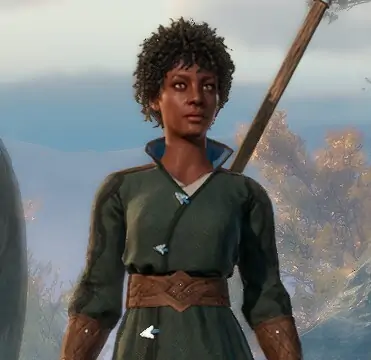
If you are looking for a diverse magic user with more spell choices at their fingertips, the Wizard is going to be for you. I should also note that wizards are generally pretty squishy so you are going to want to keep them out of melee combat as much as possible.
“Wizards master the Arcane by specializing in individual schools of magic, combining ancient spells with modern research.”
- Spell Slots Unlocked – Wizards cast spells from spell slots which are restored after a long rest.
- Intelligence Saving Throw Proficiency – Wizards gain their proficiency bonus to Intelligence saving throws. This is +2 from levels 1 to 4, and will increase to +3 at level 5, and +4 at level 9.
- Wisdom Saving Throw Proficiency – Wizards gain their proficiency bonus to Wisdom saving throws. This is +2 from levels 1 to 4, and will increase to +3 at level 5, and +4 at level 9.
- Dagger, Dart, Sling, Quarterstaff, and Light Crossbow Proficiency – Wizards add their proficiency bonus to attacks made with these weapons.
- Arcane Recovery – Once per day you can recover your used spell slots, allowing you to cast additional spells.
Skills Screen
Most of the conversation and interaction choices in the game outside of combat will require skill checks.
There are 18 skills available, and depending on your background and class choices, you will be granted proficiency in some automatically, while others you will not be able to obtain proficiency in.
In addition, you will be able to pick two additional skills to be proficient in depending on your class.
Finally, it is also important to note that the Githyanki can choose one “base skill” to gain proficiency in, which can be any of the skills on this list.
Acrobatics (Dexterity-Based Skill)
Granted automatically by the Entertainer background. Can be chosen by Fighter and Rogue Classes.
Animal Handling (Wisdom-Based Skill)
Granted automatically by the Folk Hero background. Can be chosen by Fighter and Ranger Classes.
Arcana (Intelligence-Based Skill)
Granted automatically by the Sage background. Can be chosen by Warlock and Wizard Classes.
Athletics (Strength-Based Skill)
Granted automatically by the Outlander background. Granted automatically by the Sailor background. Granted automatically by the Soldier background. Can be chosen by Fighter, Ranger, and Rogue Classes.
Deception (Charisma-Based Skill)
Granted automatically by the Charlatan background. Granted automatically by the Criminal background. Can be chosen by Rogue and Warlock Classes.
History (Intelligence-Based Skill)
Granted automatically by the Noble background. Granted automatically by the Sage background. Can be chosen by Cleric, Fighter, Warlock, and Wizard Classes.
Insight (Wisdom-Based Skill)
Granted automatically by the Acolyte background. Granted automatically by the Guild Artisan background. Can be chosen by Cleric, Fighter, Ranger, Rogue, and Wizard Classes.
Intimidation (Charisma-Based Skill)
Granted automatically by the Soldier background. Can be chosen by Fighter, Rogue, and Warlock Classes.
Investigation (Intelligence-Based Skill)
Can be chosen by Ranger, Rogue, Warlock, and Wizard Classes.
Medicine (Wisdom-Based Skill)
Granted automatically by the Hermit background.
Can be chosen by Cleric and Wizard Classes.
Nature (Intelligence-Based Skill)
Can be chosen by Ranger and Warlock Classes.
Perception (Wisdom-Based Skill)
Granted automatically by the Sailor background.
Granted automatically by the Elven Race.
Can be chosen by Fighter, Ranger, and Rogue Classes.
Performance (Charisma-Based Skill)
Granted automatically by the Entertainer background.
Can be chosen by the Rogue Class.
Persuasion (Charisma-Based Skill)
Granted automatically by the Guild Artisan background.
Granted automatically by the Noble background.
Can be chosen by the Cleric and Rogue Classes.
Religion (Intelligent-Based Skill)
Granted automatically by the Acolyte background.
Granted automatically by the Hermit background.
Can be chosen by the Cleric, Warlock, and Wizard Classes.
Sleight of Hand (Dexterity-Based Skill)
Granted automatically by the Charlatan background.
Granted automatically by the Urchin background.
Can be chosen by the Rogue Class.
Stealth (Dexterity-Based Skill)
Granted automatically by the Criminal background.
Granted automatically by the Urchin background.
Can be chosen by the Rogue and Ranger Classes
Survival (Wisdom-Based Skill)
Granted automatically by the Folk Hero background.
Granted automatically by the Outlander background.
Can be Chosen by the Fighter and Ranger Classes.
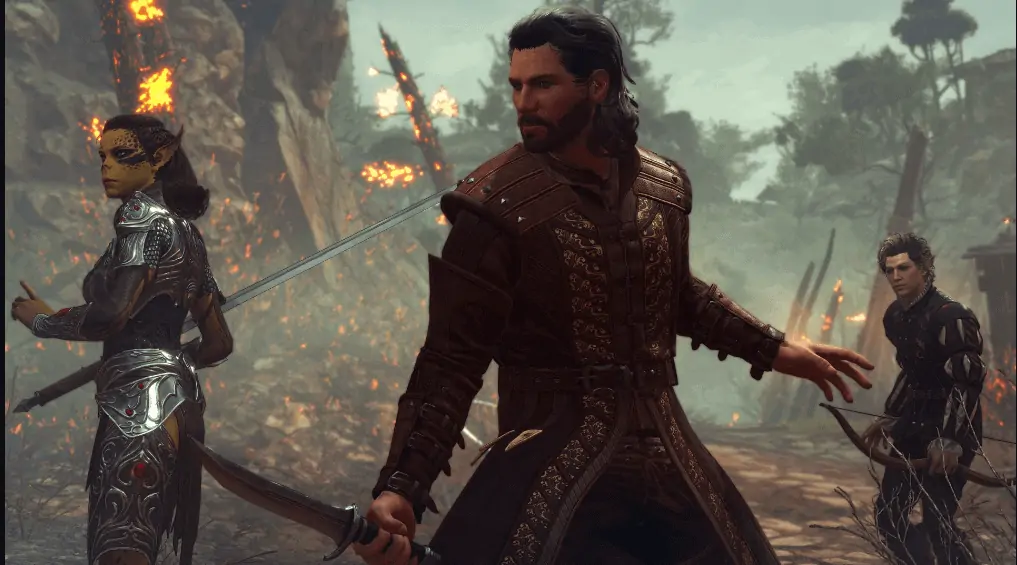
Attributes
I honestly do not know why this particular part of your character creation came after skills, but here we are.
This is where you will assign points to six attributes defining your character’s abilities. Each class has at least one primary attribute that they should put the greater portion of their points into. I will break this down for you below, don’t worry.
The first thing you should probably know, if you don’t already, is how attributes affect your character. Many abilities, skills, and spells, have modifiers that rely on attribute modifiers.
An example of this is strength-based melee attacks gain a bonus to attack rolls (to hit) and damage based on your Strength Modifier.
Attribute Modifiers increase by 1 every two points from 10 onward. I have provided a handy table below for ease of visualization.
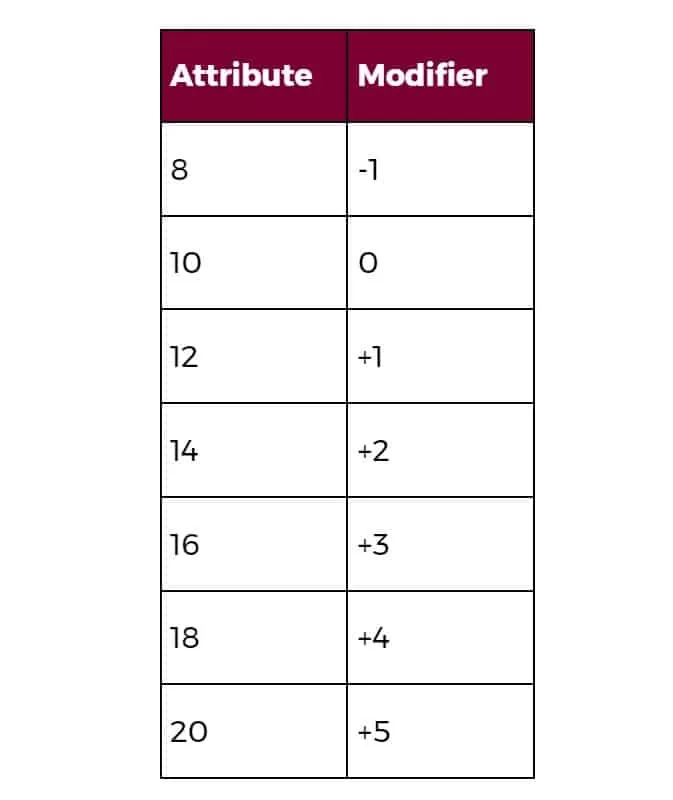
Strength
Strength is a measure of your character’s raw power. It is vital to melee combatants who use strength-based weaponry or heavier armor.
It also affects the distance your character can jump as well as the amount of weight they can carry. It is the primary attribute of Fighters.
Your Strength modifier will be added to Melee Attack Rolls with Strength-based weapons, your damage with Strength-based weapons, and your Athletics Skill.
Dexterity
Dexterity is a measure of your character’s agility. It is vital to Dexterity-based melee combatants and Ranged physical damage combatants.
It also increases your armor class and initiative rolls. It is the primary ability for Rogues and Rangers Your Dexterity modifier will be added to Melee Attack Rolls with Dexterity-based Weapons, Ranged Attack Rolls, your damage with Dexterity-based weapons, and your Acrobatics, Sleight of Hand, and Stealth skills.
It is also added to your initiative rolls, potentially allowing you to act sooner in combat.
Constitution
Constitution is a measure of your character’s vitality. It is important to every class, especially melee combatants. It increases your hit points total.
Your Constitution modifier will be added to your hit point pool at every level in addition to your class-provided hit points.
Intelligence
Intelligence is a measure of your character’s book smarts. It is vital to Wizards and it is their primary attribute.
Your Intelligence modifier will be added to your cantrip and spell attack rolls, some cantrip and spell attack damage (if applicable), and your Arcana, History, Investigation, Nature, and Religion skills.
Wisdom
Wisdom is a measure of a character’s intuition and common sense.
It is vital to Clerics and it is their primary attribute Your Wisdom modifier will be added to your cantrip and spell attack rolls, some cantrip and spell attack damage (if applicable), and your Animal Handling, Insight, Medicine, Perception, and Survival skills.
Charisma
Charisma is a measure of your character’s general likableness. It is a mixture of personality, conversational skill, and appearance. It is vital to Warlocks and is their primary attribute.
Your Wisdom modifier will be added to your cantrip and spell attack rolls, some cantrip and spell attack damage (if applicable), and your Deception, Intimidation, Performance, and Persuasion skills.
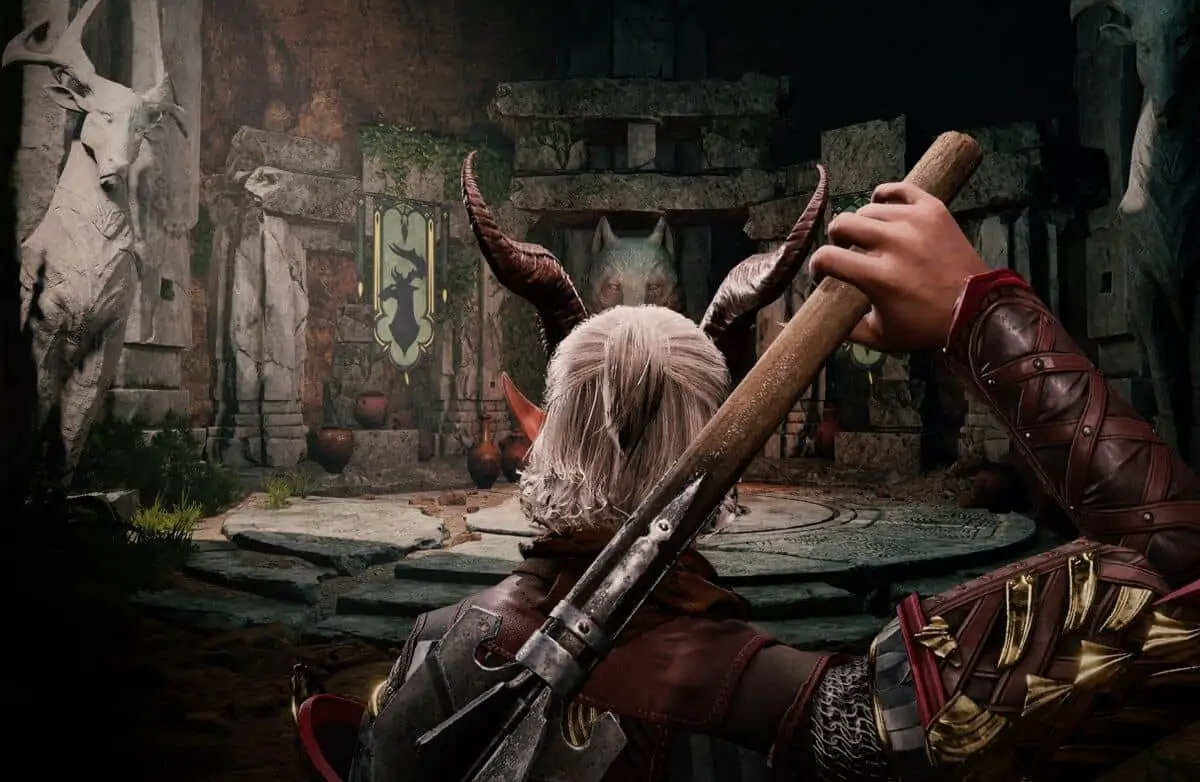
Point-Buy System
Baldur’s Gate 3 utilizes a point buy system in which you spend a pre-allocated number of points (27) in which to assign your attributes from 8 to 15.
Some of your attributes will not begin with a base of 8 and can extend beyond 15 based on the race you have chosen.
Humans for example start with all of their attributes with a base of 9 and can raise their attributes to 16 as a result of this. Typically, it is advisable to raise your primary attribute to 16 or 17, and then divide the remainder of your points into attributes for which you have skill proficiencies in or into constitution for extra hit points or dexterity for extra armor class.
Buying an attribute point is not a one-for-one affair. I have provided a table below-showing attributes and how many points it requires to purchase the “next” attribute.
I would also note that racial attribute bonuses effectively “push” the values down as detailed below.
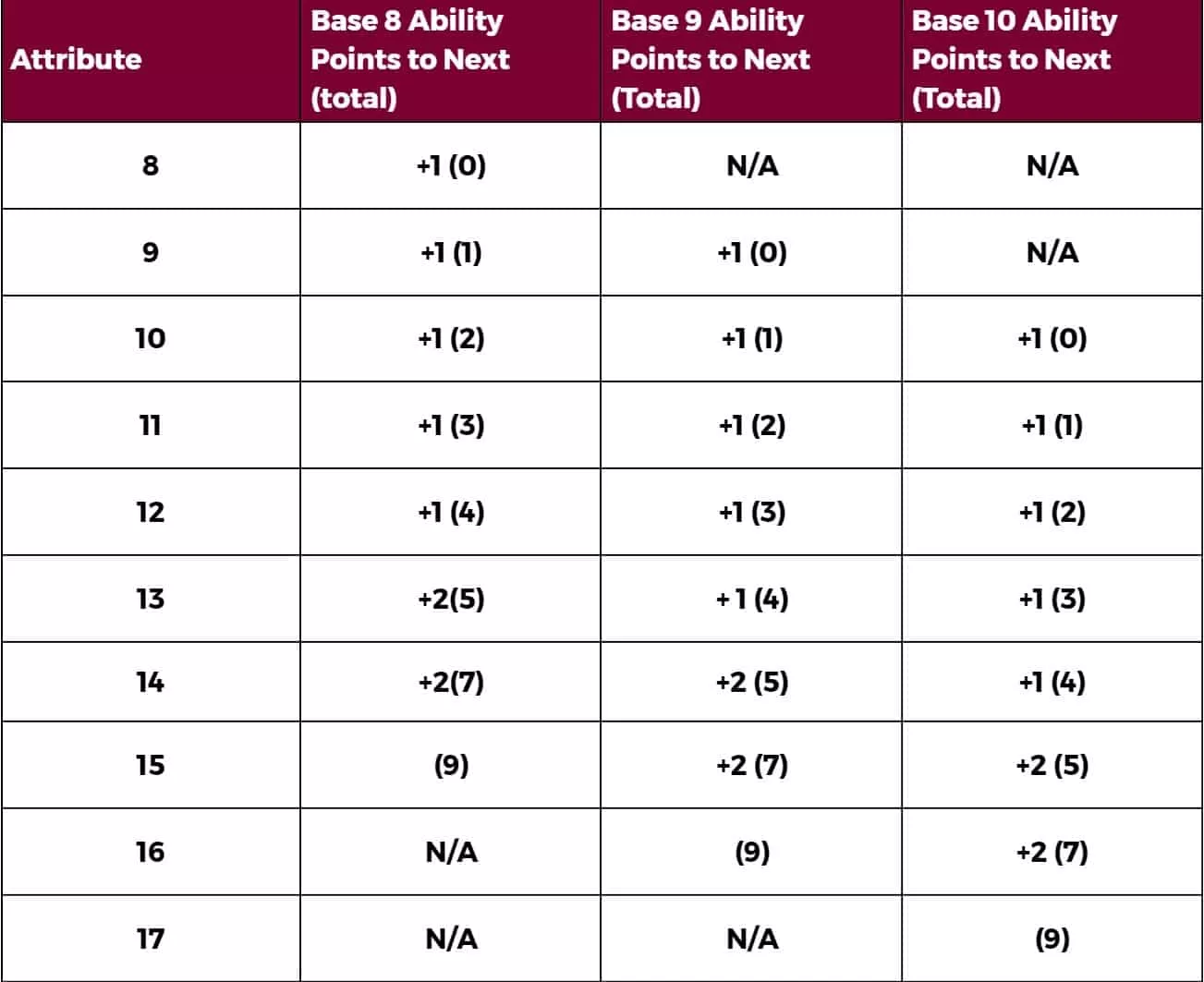
Summary
That’s it! Once you have everything all chosen hop into the game and get playing. Good luck with your brain slug adventurer!
This comprehensive guide provides tips and insights for mastering Balder’s Gate 3’s character creation system. It explains how to customize every aspect of your character’s appearance, race, class, skills, and personal history. The guide also emphasizes the impact of these choices on the game, such as influencing interactions with non-player characters and shaping the trajectory of the story. It includes information on the available origins, backgrounds, and races, providing detailed descriptions of each option and their unique abilities. Whether you want to be a cunning rogue, powerful mage, or noble warrior, this guide will help you craft your ideal hero.
Source: gaminggorilla.com
Hashtags: #Balders #Gate #Character #Creation #Guide






 24hMinecraft is a Minecraft community created by fans, where users can share and download their favorite shader packs, mods, maps, texture packs, or expand their knowledge with our guides.
24hMinecraft is a Minecraft community created by fans, where users can share and download their favorite shader packs, mods, maps, texture packs, or expand their knowledge with our guides.
Leave a Reply